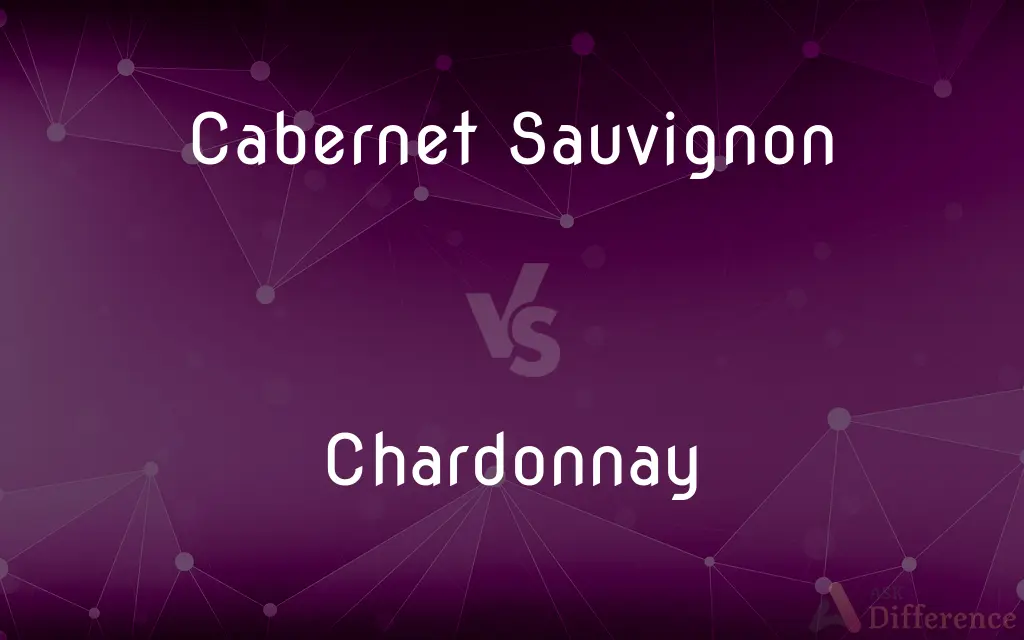Cabernet Sauvignon vs. Chardonnay — What's the Difference?
By Tayyaba Rehman — Published on February 11, 2024
Cabernet Sauvignon and Chardonnay are wine varieties. Cabernet Sauvignon is a red wine known for boldness and tannins, while Chardonnay is a white wine celebrated for its versatility and buttery notes.

Difference Between Cabernet Sauvignon and Chardonnay
Table of Contents
ADVERTISEMENT
Key Differences
Cabernet Sauvignon, a robust red wine, originates from Bordeaux. It's renowned for deep color, high tannins, and flavors like blackcurrant. This varietal often undergoes oak aging, adding complexity. Chardonnay, a versatile white wine, hails from Burgundy. It exhibits a wide flavor spectrum, influenced by winemaking techniques. Unoaked versions highlight fruitiness, while oak-aged Chardonnay can offer buttery and vanilla notes.
Cabernet Sauvignon, with its bold character, pairs well with red meats and aged cheeses. Its aging potential allows for cellaring, enhancing complexity over time. Chardonnay, adaptable and food-friendly, complements dishes from seafood to creamy pasta. Unoaked Chardonnay suits lighter fare, while oak-aged options suit richer, buttery dishes.
In terms of grape characteristics, Cabernet Sauvignon grapes are small, thick-skinned, and dark, contributing to the wine's robust nature. Chardonnay grapes vary widely, adapting to different climates and winemaking styles, leading to a diverse range of expressions. Climate plays a crucial role; Cabernet Sauvignon thrives in warmer regions, while Chardonnay displays versatility in various climates.
Cabernet Sauvignon often boasts higher alcohol content compared to Chardonnay. The tannins in Cabernet Sauvignon contribute to its structure and aging potential. Chardonnay's alcohol levels can vary, but it generally has a smoother profile, with acidity and fruitiness playing key roles. Both varietals showcase regional nuances, with Cabernet Sauvignon expressing terroir through bold red fruit flavors, and Chardonnay displaying terroir through its diverse aromatic profile.
Comparison Chart
Wine Type
Red
White
ADVERTISEMENT
Flavor Profile
Bold, high tannins, blackcurrant
Versatile, fruity, buttery (oaked)
Food Pairing
Red meats, aged cheeses
Seafood, creamy pasta, adaptable
Grape Characteristics
Small, thick-skinned, dark grapes
Varies widely, adaptable to climates
Alcohol Content
Often higher
Variable, generally smoother profile
Compare with Definitions
Cabernet Sauvignon
Bold Red Wine: Cabernet Sauvignon is a bold red wine.
Cabernet Sauvignon is celebrated for being a bold red wine, known for its robust flavors.
Chardonnay
Buttery (Oaked) Notes: Oaked Chardonnay can offer buttery notes.
Oaked Chardonnay is known for its buttery notes, adding richness and depth to the wine.
Cabernet Sauvignon
Cellaring Potential: Cabernet Sauvignon has aging potential.
Cabernet Sauvignon's cellaring potential allows it to develop complexity and improve over time.
Chardonnay
Fruity Profile: Unoaked Chardonnay highlights fruitiness.
Unoaked Chardonnay showcases a fruity profile, making it a refreshing choice for lighter dishes.
Cabernet Sauvignon
Blackcurrant Flavors: Cabernet Sauvignon features blackcurrant flavors.
Cabernet Sauvignon is characterized by its distinctive blackcurrant flavors, adding depth to the wine.
Chardonnay
Versatile White Wine: Chardonnay is a versatile white wine.
Chardonnay is celebrated as a versatile white wine, adapting to various winemaking styles.
Cabernet Sauvignon
High Tannins: Cabernet Sauvignon exhibits high tannins.
The high tannins in Cabernet Sauvignon contribute to its structured and age-worthy nature.
Chardonnay
Adaptable Food Pairing: Chardonnay is food-friendly.
Chardonnay's adaptability makes it a great choice for pairing with a range of dishes, from seafood to creamy pasta.
Cabernet Sauvignon
Oak Aging Complexity: Cabernet Sauvignon often undergoes oak aging.
The oak aging process in Cabernet Sauvignon enhances its complexity, offering layers of flavors.
Chardonnay
Diverse Aromatic Profile: Chardonnay displays diverse aromatics.
Chardonnay's diverse aromatic profile reflects the influence of different climates and winemaking techniques.
Chardonnay
A variety of grape originally grown in the Burgundy region of France that is used to make white wine, including champagne.
Chardonnay
A dry white wine made from this grape.
Chardonnay
Alternative case form of Chardonnay
Chardonnay
A white wine grape.
Chardonnay
Dry white Chablis-type table wine made from Chardonnay grapes.
Chardonnay
White wine grape
Chardonnay
Dry white table wine resembling Chablis but made from Chardonnay grapes
Common Curiosities
What foods pair well with Cabernet Sauvignon?
Cabernet Sauvignon pairs well with red meats and aged cheeses.
What are key characteristics of Cabernet Sauvignon grapes?
Cabernet Sauvignon grapes are small, thick-skinned, and dark in color.
How do Chardonnay grapes vary?
Chardonnay grapes vary widely, adapting to different climates and winemaking styles.
What are key characteristics of Chardonnay's flavor profile?
Chardonnay's flavor profile can range from fruity to buttery, especially in oaked versions.
Does Cabernet Sauvignon have aging potential?
Yes, Cabernet Sauvignon has aging potential, allowing it to develop complexity over time.
What is Chardonnay?
Chardonnay is a white wine known for its versatility and diverse flavor profile.
What is Cabernet Sauvignon?
Cabernet Sauvignon is a red wine known for its boldness, high tannins, and flavors like blackcurrant.
Where does Cabernet Sauvignon originate from?
Cabernet Sauvignon originates from Bordeaux, France.
Where does Chardonnay originate from?
Chardonnay originates from Burgundy, France.
What makes Chardonnay adaptable to different winemaking styles?
Chardonnay's adaptability is influenced by winemaking techniques, leading to a diverse range of expressions.
What is a notable characteristic of Cabernet Sauvignon's grape composition?
Cabernet Sauvignon grapes are known for being small, thick-skinned, and dark, contributing to the wine's robust nature.
What foods pair well with Chardonnay?
Chardonnay is food-friendly and pairs well with seafood, creamy pasta, and various dishes.
How do Cabernet Sauvignon and Chardonnay differ in terms of wine type?
Cabernet Sauvignon is a red wine, while Chardonnay is a white wine.
Which wine type often has higher alcohol content, Cabernet Sauvignon or Chardonnay?
Cabernet Sauvignon often has higher alcohol content compared to Chardonnay.
Does Chardonnay have different styles?
Yes, Chardonnay has different styles, with unoaked versions highlighting fruitiness and oaked versions offering buttery notes.
Share Your Discovery

Previous Comparison
SD Card vs. SDHC
Next Comparison
Diego Maradona vs. PeléAuthor Spotlight
Written by
Tayyaba RehmanTayyaba Rehman is a distinguished writer, currently serving as a primary contributor to askdifference.com. As a researcher in semantics and etymology, Tayyaba's passion for the complexity of languages and their distinctions has found a perfect home on the platform. Tayyaba delves into the intricacies of language, distinguishing between commonly confused words and phrases, thereby providing clarity for readers worldwide.













































